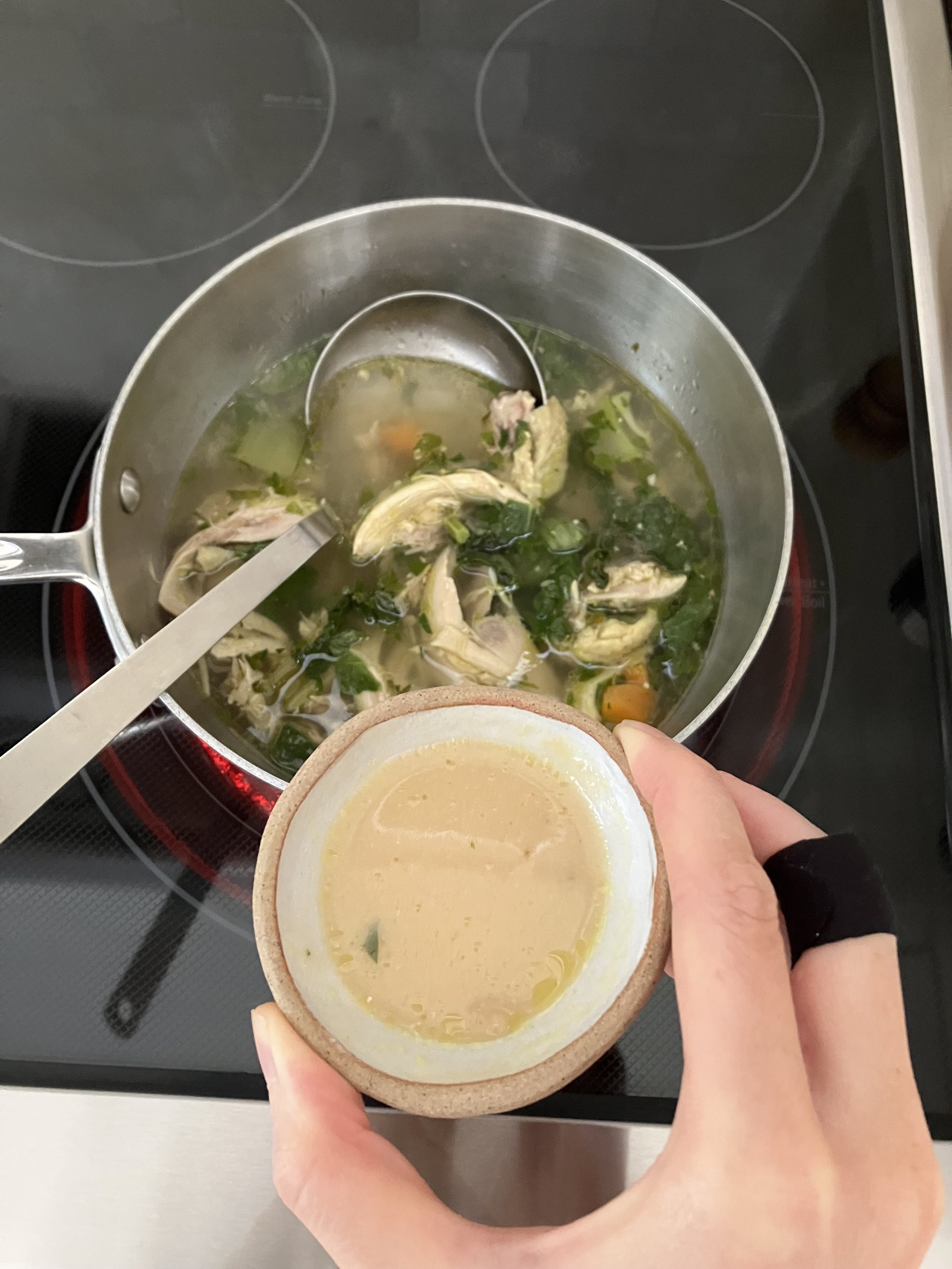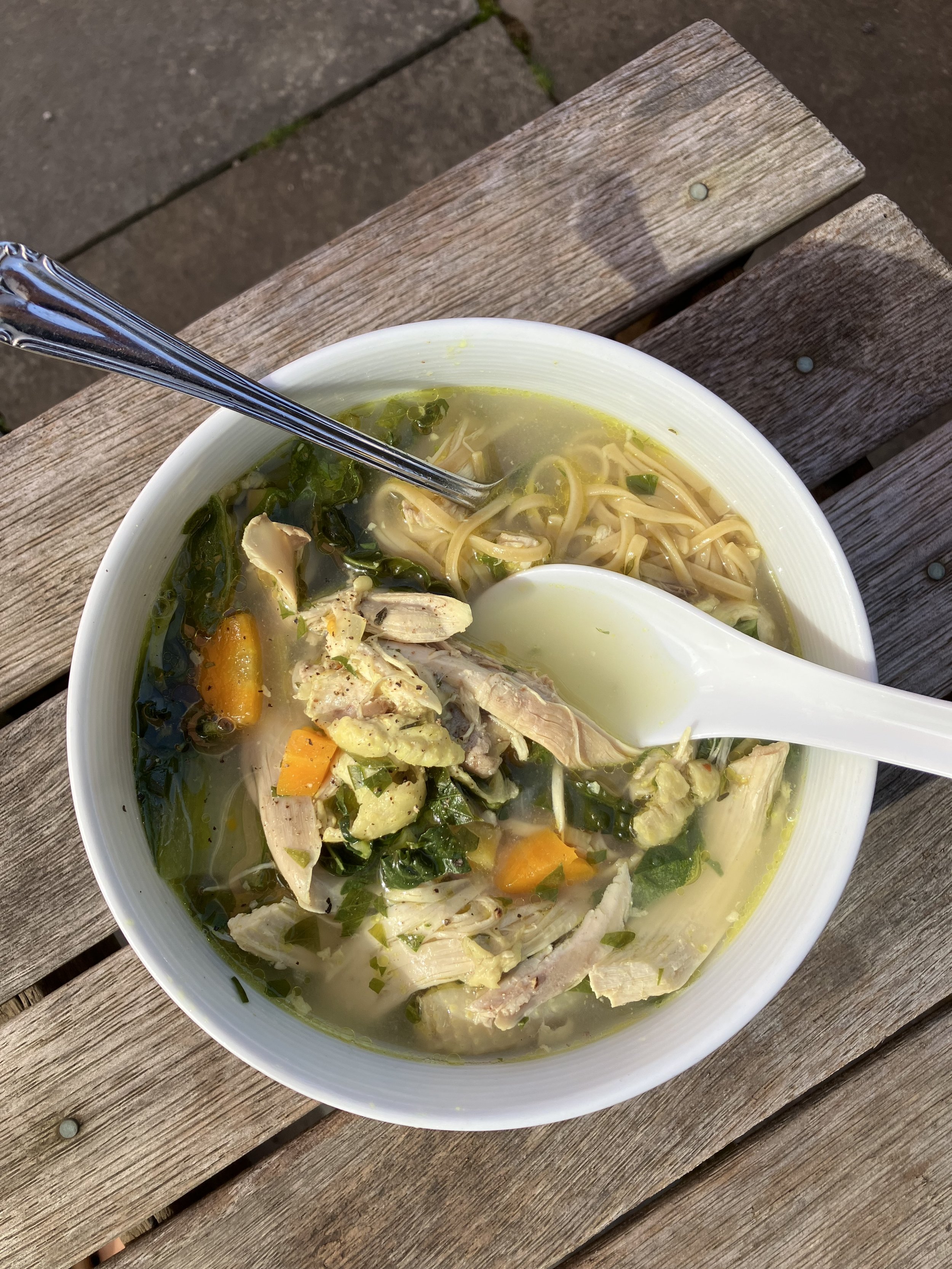Pasture-Raised Chicken Soup with Dulse, Herbs and Greens
…and plenty of greens, at that. Chicken soup has become a total staple in my diet with its restorative, nourishing, grounding and soul healing powers. It’s a soup that we often only fall back on in times of acute illness or fatigue, but I enjoy this recipe so much that it’s a regular, preventative part of my meal rotations, especially during the colder seasons. Soup is the ultimate comfort food, and it turns out that it’s pretty aligned with TCM (Traditional Chinese Medicine) and other ancient principles, too. Take care of your spleen and stomach with this warm and nourishing pasture raised chicken soup! Move over, canned and packaged, processed food-like products; anything that comes in a package simply cannot replicate the healing powers of a soup made from scratch like this.
There’s just something about the simple combination of the lemon, ginger, fresh thyme and subtle chili spice that’s divine. The recipe itself is super simple, primal and pro-metabolic, and very versatile. You can choose your own veggies as you please, there are really no limits… I’ve opted for a divine and delicious balance of anti-inflammatory organic local greens, carrots, Atlantic dulse seaweed, lemon, herbs, and ginger. You can always go classic with just carrots, celery, parsley, and rice (or other GF) noodles, or whatever’s hanging out in the back of your fridge.
It doesn’t look like much, but this is some of the purest wild spring water on earth (Elmvale, Ontario). In nature, springs carry energy equivalent to that of a temple or holy place. We ought to treat these areas with respect and reverence. Visit findaspring.com to locate one nearest you, usually for free.
We all know the immense benefits of properly sourced bone broth, and boiling the entire chicken will offer a hearty dose of gut healing properties and protective nutrients such as collagen, gelatin, glycine, and a rich store of beneficial minerals, a gift to the body you live in, which work in tandem with sunlight on the skin, free electrons and barefoot earthing to support your cellular water network and mitochondrial integrity.
Chicken soup is one of the easiest ways to eat “nose-to-tail”. The mix of white chicken meat and the more nutritious dark chicken meat ensures you get a hefty dose of minerals such as iron, zinc and selenium, as well as vitamins A, K, and B-complex vitamins. This recipe can also be rich in iodine which can help detoxify fluoride if you add things like seaweed/dulse flakes. Using a whole chicken is higher in the beneficial saturated animal fats (read the work of Weston A. Price), which is a great thing when you’re consuming high quality, ethically pasture-raised organic meats. Most nutrients are stored in the fat and most agricultural soils are depleted of nutrients and minerals, so by choosing high-quality animal protein and opting for the fattier cuts, you really reap the benefits, particularly for the brain in my experience. The whole carcass is full of cartilage and connective tissue, which is a great source of collagen (aka body glue), and to top it off I actually recommend adding in a few chicken feet for the broth as well (optional if you can find them, but so beneficial). They really didn’t call it “chicken soup for the soul” for nothing. Soup heals, my friends. I hope you enjoy this soup as much as I do!
Ingredients:
Rebuild the body from the ground up. Add in any herbs you like that work for you! I switch it up all the time.
1 tbsp cooking fat of your choice (the most beneficial kinds with high smoke points include cold-pressed coconut oil, nitrate-free lard, grass-fed and finished beef tallow or suet, and grass-fed ghee)
3-4 organic shallots, sliced (or 1 onion, fine dice)
2-3 medium organic carrots, diced
2 stalks organic celery, chopped
6 cloves organic garlic, minced (yes, six)
1-inch knob of organic ginger root, minced (skin on is fine, I like to store chopped fresh ginger in a bag in the freezer)
1 tsp organic chili flakes (optional, to taste)
2 tsp organic ground turmeric (fresh minced turmeric works too)
1 tsp sea salt and organic black pepper, to taste
4-5 sprigs organic thyme (I used homegrown)
1 tbsp wildcrafted dulse flakes, OR a 4-inch piece of other dried organic/wildcrafted sea vegetable
1 whole organic pasture-raised roaster chicken (frozen or thawed in the refrigerator overnight)
6-8 cups wild spring water (or reverse osmosis filtered water), or enough to cover the chicken without overflowing the pot/slow cooker
2 tbsp + 2 tsp raw organic apple cider vinegar (with the ‘mother’), divided
1 1/2 cups shredded organic napa, or other green cabbage or cruciferous veg
1 cup organic bok choy, cut into strips (or organic kale, or organic/wild unsprayed dandelion leaves)
1/3 cup, or a handful of chopped organic flat leaf parsley
1/2 freshly squeezed organic lemon, to garnish
Optional: 1-2 tsp organic chickpea miso paste with 1-2 tsp raw organic apple cider vinegar, dissolved in the soup at the end of cooking or with any leftovers, a dollop of beef liver pâté dissolved into the soup, and cooked organic soba (buckwheat) or organic rice noodles
Instructions:
After you make this pasture-raised chicken soup, you’ll have leftovers for days. I like to heat it up with a dollop of liver pâté and a miso and apple cider vinegar slurry, served with cooked rice noodles!
In a large soup pot over medium, heat up the tallow. Once melted, add the shallots/onion, carrots and celery (mirepoix). Sauté and stir the vegetables until the shallots are soft and translucent, about 4 minutes.
Add the garlic and ginger. Stir until fragrant, about 30 seconds. Add the chili flakes, turmeric, sea salt, black pepper, thyme sprigs and dulse flakes. Stir to combine the spices, herbs and oil with the vegetables.
Carefully add the whole chicken, then fill the pot to cover the chicken as much as you can with spring water. Add in 1 tbsp (or a splash) of apple cider vinegar, as this will help draw the beneficial minerals out of the bones and into the soup. Bring the water to a full boil on medium-high for 15-20 minutes, cover with a lid, then lower to a simmer for 90-120 minutes.
After 90 minutes, the chicken should be just about cooked and might still be a little pink inside. Remove from heat. Carefully remove the chicken and place it on a tray to the side, letting it cool slightly for a few minutes. As the soup simmers, shred all meat off of the bones using your hands and/or a fork. Save the bones for making a separate broth in another recipe, or discard them. Add the shredded meat back into the soup to simmer so that the meat is fully cooked and no longer pink.
Add the cabbage, bok choy and parsley to the pot (or your choice of leafy green organic veggies), then stir and raise the heat to medium-low until it begins to simmer and the greens melt into the soup. In a small bowl using a fork, stir 2 tsp organic miso with 2 tsp organic apple cider vinegar until it turns into a slurry. Remove the soup from heat and stir in the slurry.
Season the soup generously with sea salt and pepper. Serve hot with freshly squeezed lemon juice and cooked rice noodles.
Tips:
Meals under sunlight (al fresco) always taste best. When you do this every day, it helps consistently calibrate your circadian rhythm and improves digestion and nutrient assimilation! Even if you're alone, and even if there’s no special occasion, it’s vital to get outside under sunlight.
Currently, I source regeneratively raised meats from Wild Meadows Farm Ontario. Use code ROOTTOSKY for $10 off your first order at wildmeadowsfarm.ca.
The splash of apple cider vinegar helps draw the beneficial minerals out of the chicken bones. This is a common practice with bone broths in general.
Use an old-fashioned big soup pot, or simply throw everything into a slow cooker on high for 3-4 hours (until chicken is fully cooked).
Keep leftovers in the fridge for up to 5 days. Freeze for several months.
Boil and simmer the soup containing the bones thoroughly! You can even extend the recommended simmering time to 120 minutes or more. A diet full of solely muscle meats and indoor living is a long term recipe for disaster, so make sure to mix it up with bone broth, organs and other parts of animal foods for the most balanced nutritional profile. Bone broth (collagen) is a great source of glycine which rounds out the methionine (in muscle meats) to glycine ratio. You could also add grass fed gelatin powder to your meats, or use bone broth gravy if you’re more of a steak and grill person (and include protective cooking herbs to offset the effects of any burnt meat).
Mix it up! You can freely choose whatever veggies you can access or are in season! I recommend using at least one sea vegetable and one land vegetable.
You can stir in 2 tsp organic miso paste towards the end as the soup simmers for an extra umami flavour dimension and probiotic dose. Organic miso is an incredibly beneficial food that can help with the digestion of wheat and rice due to its massive amounts of phytase that can break down essentially any plant food. Great pairing, if you ask me. Soybean miso is fine in my opinion as long as it's organic, but chickpea or even barley/rice miso can work well, too, depending on your preference. Miso shouldn’t be boiled as this kills the beneficial enzymes, and I tend to have lots of leftovers, so I like to add in the slurry when I gently heat leftovers/small batches as I go through them.
Feel free to include noodles or cooked and cooled white rice of your choice. I tend to consume properly sourced grains only once in a blue moon. The only pasta I use is either legume, rice or cassava-based or sourced from Italy, certified organic, and ensuring the grains are not fortified with toxic iron filings (isolated lab-made "vitamins" that accumulate in your organs).
Fresh ginger root is pungent and heating, according to ancient Ayurvedic wisdom. It has a different post-digestive effect than dried ginger, though both are beneficial in their own ways. Ginger can kindle digestive fire, improving digestion, relieving nausea, and promoting effective absorption and assimilation of nutrients. Ginger can improve circulation, relieve congestion, help break down blood clots and may aid in preventing heart attacks. It's a great remedy for the common cold, cough and respiratory issues. I recommend using it.
As usual, omit or replace any ingredients you don't do well with!
Pasture-raised turkey is also a great alternative option and can offer a more well-rounded nutrient profile. You can use the whole turkey if there’s room, or even just half, or a few drumsticks or wings in the soup instead. I recommend you source your chicken/turkey from an ethical local farmer you trust, pasture-raised, freely roaming outdoors under the sun, and fed natural probiotics and organic feed (no soy or corn), and vegetable scraps, grass and various bugs from the unsprayed pasture. Even just one properly sourced chicken or turkey is incredibly economical, the meat can last an entire week and the bones can be simmered later as a highly nutrient-dense, healing broth. Respect yourself, avoid low-quality chicken and all other commercially farmed animal foods whenever possible, proper nutrition is not a game.
Meals for days.
Purple carrots = purple broth
This chicken soup recipe can be found in my upcoming book, The Vital Life Cookbook.
















